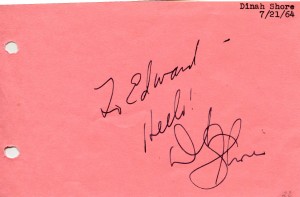Dinah Shore was one of America’s most popular singers during the 1940’s and 50’s. In the 1970’s she was a very famous TVhost. She did too make some movies such as “Up In Arms” in 1944 opposite Danny Kaye and “Follow the Boys”. She was born in 1916 in Tennessee and died in Beverly Hills in 1998.
Dick Vosburgh’s “Independent” obituary:
A SINGER who lights a fire by rubbing two notes together’. Thus was the 23-year-old Dinah Shore introduced on The Chamber Music Society of Lower Basin Street, a 1940 radio show. The sultry-voiced newcomer from Tennessee went on to become one of the United States’ most enduringly popular recording stars and television personalities.
Her professional singing career began in 1938 at WNEW, a New York radio station, where she sang for nothing. Like Frank Sinatra, who was also singing there gratis, she stepped in whenever an appropriate musical ‘filler’ was needed. Unlike Sinatra (and her rivals Peggy Lee, Doris Day and Ella Fitzgerald), Shore didn’t graduate from a big band; she was turned down by Tommy Dorsey, Benny Goodman and Woody Herman, but made her recording debut in 1939, singing with Xavier Cugat’s orchestra. (On the label she was billed as ‘Dinah Shaw’.) Next came her Chamber Music Society of Lower Basin Street appearances, after which Eddie Cantor signed her for his radio series. Shore was Jewish, and found ideal material in ‘Yes, My Darling Daughter’, adapted from a Yiddish folk song. Introduced on Cantor’s show, it became her first best-
selling record. The first of her nine million-sellers was ‘Blues in the Night’ (1941).
In 1943 she married the actor George Montgomery, then serving in the US Army. They had met at the Hollywood Canteen, where Shore sang regularly. Throughout the war she entertained servicemen all over the world. ‘There’s nothing to compare with the enthusiasm of those GIs,’ she told me in a radio interview. ‘You don’t find that much applause lying around loose for the rest of your life]’
In 1946, shortly after signing with Columbia Records, she was given the novelty number ‘Shoo-Fly Pie and Apple Pan Dowdy’ to record. She found the song ludicrous, especially as shoo-fly pie is a southern dessert and apple pan dowdy a New England one. To her amazement, the record sold 40,000 copies, and was swiftly followed by three million-sellers: ‘The Gypsy’, ‘Doin’ What Comes Natur’lly’ and ‘For Sentimental Reasons’. Billboard proclaimed her Top Female Vocalist of 1946.
Shore’s film career had begun with Thank Your Lucky Stars (1943), in which she played herself. No more demanding were her roles in Follow the Boys and Belle of the Yukon (both 1944). She got to clown a little and sing ‘Tess’s Torch Song’ and ‘Now I Know’ in Danny Kaye’s first film, Up in Arms (also 1944), and never photographed better than in the fictionalised Jerome Kern biopic Till the Clouds Roll By (1946). She lent her voice to two Disney cartoon features, Make Mine Music (1946) and Fun and Fancy Free (1947). Her best screen performance was in Aaron Slick from Punkin Crick (1951), but that musical was so disastrous that she didn’t film again for 26 years.
She hardly needed to; 1951 was also the year she entered television. Variety wrote that she had ‘a charm and ease that established her right off as one of TV’s standout personalities’. A minority view was expressed by Oscar Levant, who found her too effusive. ‘My doctor won’t let me watch Dinah,’ he claimed. ‘I’m a diabetic.’
Her television success (she won 10 Emmy Awards in all) caused a career clash with George Montgomery, and they were divorced in 1962. In 1963 Shore married a building contractor, but the marriage was over by 1964. She retired for five years to devote herself to two children from her first marriage, returning to television in 1970 as a talk show hostess in Dinah’s Place. One of her guests was Burt Reynolds, with whom she began a long, tabloid-titillating relationship.
She was seen again on the cinema screen in the George Burns comedy Oh God] (1977) and in Robert Altman’s HEALTH (1979). From 1989 to 1991 she presented the talk show Conversation with Dinah.
The above “Independent” obituary can also be accessed online here.


